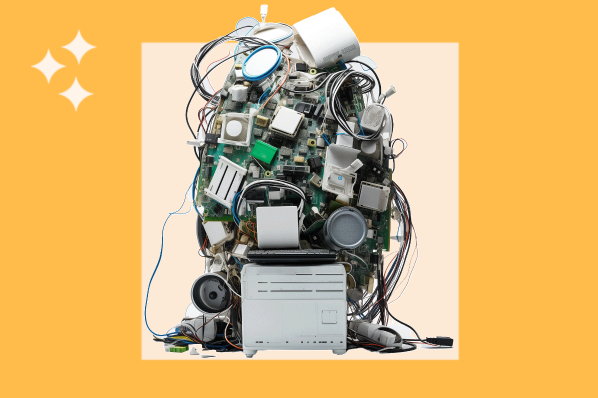So, what the heck are GPUs?
The easiest way to understand GPUs is to imagine you’re working in a field that requires specialized equipment. Take dentistry, for example.
Just as a dentist relies on specific instruments to care for your smile, GPUs operate as specialized tools that enhance AI’s capabilities.
In the same way that drills, probes and X-rays empower dentists to provide precise oral care, GPUs enable cutting-edge AI models like OpenAI’s ChatGPT and Google’s Gemini to perform mathematical calculations and analyze massive quantities of data swiftly and efficiently.
One of the earliest pioneers of GPU development was — you guessed it — Nvidia. In 1999, the company created one of the first GPUs, GeForce 256, and has since released various others.
Before GPUs, central processing units (CPUs) served as the primary powerhouses of computing devices and were referred to as the ‘brains’ of computational systems.
But unlike CPUs, GPUs can:
- Perform specialized tasks simultaneously, a capability known as parallel processing.
- Significantly increase a computer's performance to levels associated with a supercomputer.
- Work with many other software components, establishing an extensive and intricate ecosystem.
In other words, if CPUs represent the everyday items in a dentist’s toolkit, like tartar scrapers and mouth mirrors, GPUs are the digital X-rays and dental lasers.
These attributes make the chips ideal for highly advanced applications like artificial intelligence, specifically generative AI.
As a result, the silicon-based microprocessors have quickly become one of tech’s most coveted commodities.
How did Nvidia become the top AI hardware provider?
The Silicon Valley chip maker, co-founded by its current CEO, Jensen Huang, generated just over $22 billion in revenue for its fiscal fourth quarter that ended Jan. 28, profiting roughly $12 billion.
But it didn’t achieve this success overnight.
Nvidia rose to the top of the AI food chain – and remains there – for three core reasons:
1. They invested big-time into the AI industry before most competitors even realized what was happening; Huang told GTC conference attendees in 2020 that “the age of AI is in full throttle.”
2. They consistently create chips with superior, cutting-edge technology.
3. Numerous components of AI infrastructure have already been constructed around its products.
For a closer look, here’s a brief history of the Santa Clara-based company:
- 1993: Jensen Huang establishes Nvidia with Chris Malachowsky and Curtis Priem to advance video game graphics.
- 1999: Nvidia invents the first widely available GPU, positioning itself to redefine the computing landscape.
- 2006: Huang unveils CUDA, a new software technology that broadens the capabilities of GPUs, enabling them to complete tasks in fields like science and research.
- 2012: Researchers spark the age of modern AI by using GPUs to recognize specific items in images with humanlike accuracy. Nvidia quickly dedicates every facet of its company to advancing this novel field, ultimately forming a team that creates and trains language models.
- 2018: Nvidia takes computer graphics to a new level with the first GPU capable of mimicking how light behaves in the real world in real-time through ray tracing.
- 2022: Nvidia announces the production of new chips, H100s, explicitly designed for AI applications.
- 2024: The company releases its most powerful chip to date, the GH200 Grace Hopper Superchip, which is capable of superior large language model (LLM) training and inference.
“The thing that we understood is that this is a reinvention of how computing is done,” Huang said in a New York Times interview. “And we built everything from the ground up, from the processor all the way up to the end.”
And as Gil Luria, a senior financial analyst at D.A. Davidson Companies, told Vox, “Their competitors were asleep at the wheel.”
Can I purchase AI hardware chips?
Technically, yes, but it’s a bit complicated.
The highly sought-after chips, often compared to “rare earth minerals,” are tough to acquire. This is partly because:
- Nvidia has built a “competitive moat” around the AI chip market.
- OpenAI’s introduction of ChatGPT in late 2022 triggered a tech-industry arms race.
- The Taiwan Semiconductor Manufacturing Company (TSMC), the biggest semiconductor maker globally, has long struggled to meet demand. (A GPU is a type of semiconductor.)
- Demand surged during the pandemic, then fell, slowing production — and then surged again.
Put simply, all of this has created a shortage.
“Accelerated computing and generative AI have hit the tipping point,” Huang said in a February statement to The Associated Press. “Demand is surging worldwide across companies, industries and nations.”
Some of Nvidia’s clients in 2023 reported waiting nearly a year to get their hands on the chips, some of which, by the way, can cost upwards of $40,000.
“Well, I don’t think we’re going to catch up on supply this year. Not this year, and probably not next year,” the CEO told WIRED in February.
Yet, Huang maintains that his chips’ superior capabilities warrant their hefty price tags and ultimately save customers money.
“If you can reduce the time of training to half on a $5 billion data center, the savings is more than the cost of all of the chips,” he said to The New York Times. “We are the lowest-cost solution in the world.”
Perhaps the most exciting aspect of this arms race, though, is that Nvidia is both a competitor and a judge.
The chip giant openly competes with its customers, and given its hold on the market, Nvidia must decide who gets its chips and how many. Thus, the trillion-dollar company can essentially determine which tech firms come out on top and which do not.
This is likely why companies like OpenAI are considering building their own tech. While the cost is high, they’re also huge upside.
What does all this mean for the future of AI?
Not to sound dramatic, but the future of AI depends on GPUs from Nvidia and other similar companies.
While competition remains strong, various experts foresee Nvidia maintaining its position as an industry leader.
However, Nvidia relies heavily on TSMC to manufacture its chips, meaning any future supply chain disruptions could ripple throughout the AI industry.
As a result, demand for more domestically produced semiconductors has grown.
In 2022, U.S. President Joe Biden signed into law an act incentivizing tech companies to produce semiconductors in the United States. However, some say that soaring demand for chips will outpace the rate at which US-based efforts can expand. Only time will tell.
For now, Huang remains highly optimistic about AI’s future.
In the WIRED interview, he said Nvidia was actively working on various projects, including a new data center, or “AI factory,” and a super-high-performing GPU called Blackwell.
“The goal is to reduce the cost of training models tremendously,” he said of the new GPU. “Then people can scale up the models they want to train.”
Huang also mentioned humanoid robots. Yes, you read that correctly.
“If you could generate text, if you could generate images, can you also generate motion? The answer is probably yes,” Huang told WIRED. “And then if you can generate motion, you can understand intent and generate a generalized version of articulation. Therefore, humanoid robotics should be right around the corner.”
With a history of innovation and a sharp focus on groundbreaking technology, Nvidia consistently sets a high bar in the AI world.
It seems everyone will know its name soon enough.
Artificial Intelligence




![AI email subject lines that drive 3x more revenue and actually convert [+ exclusive insights]](https://53.fs1.hubspotusercontent-na1.net/hubfs/53/ai-email-optimization-1-20251014-4500151-1.webp)






-1-20250905-2237709%202.webp)